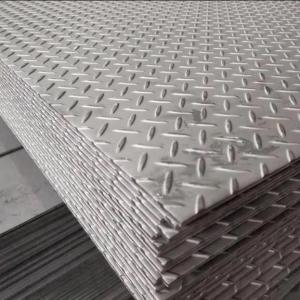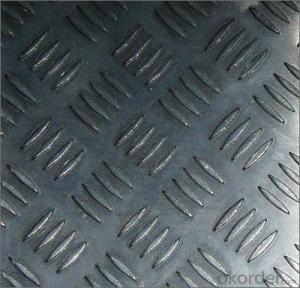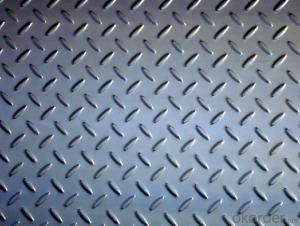Hot Rolled Steel Chequered Skid Resistance Sheets Chequer Plates
- Loading Port:
- China main port
- Payment Terms:
- TT or LC
- Min Order Qty:
- 25 m.t.
- Supply Capability:
- 10000 m.t./month
OKorder Service Pledge
OKorder Financial Service
You Might Also Like
Hot Rolled Steel Chequered
The steel surface with a pattern called chequered, its pattern into lentil-shaped, diamond, round bean-shaped, oblate shape mixed.
Features
Checkered appearance, can slip, strengthen performance, saving steel and many other advantages.
In transportation, construction, decoration, floor surrounding equipment, machinery, shipbuilding and other fields have a wide range of applications.
Generally, parties to checkered mechanical properties, mechanical performance requirements, so checkered pattern quality mainly as flowering rate, the pattern height, elevation pattern.
Currently on the market common thickness ranging from two kinds of width are common 1250,1500mm from 2.0-8mm.
Specifications
1. Plate width 600 ~ 1800mm, 50mm press upgrade; length of 2000 ~ 12000mm, press the 100mm upgrade.
2. High grain pattern is not less than 0.2 times the thickness of the substrate. Size does not figure as a finished check basis.
3. Plate steel grades according to GB / T700, GB / T712, GB / T4171 requirements.
4. Mechanical properties of steel does not guarantee, when required by the demand side, according to standard regulations, but also by mutual agreement.
5. Hot-rolled steel sheet delivery.
Pictures
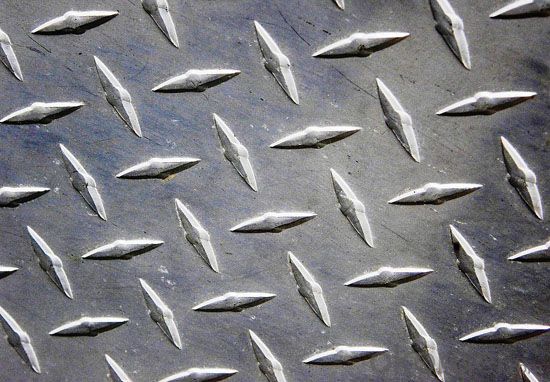
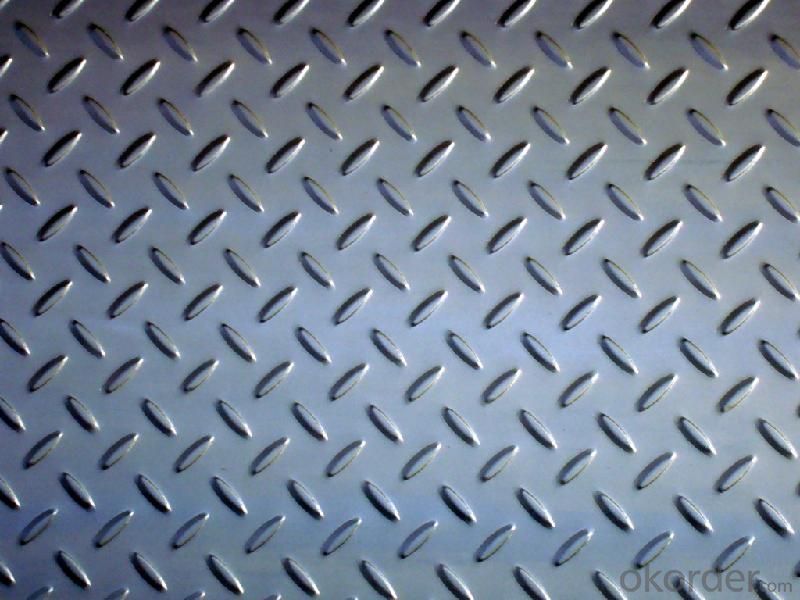
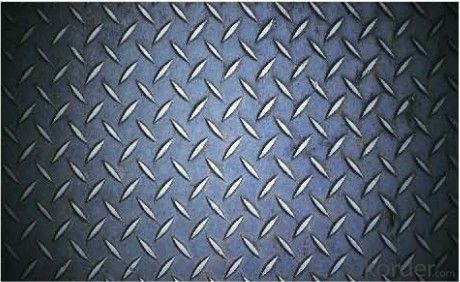
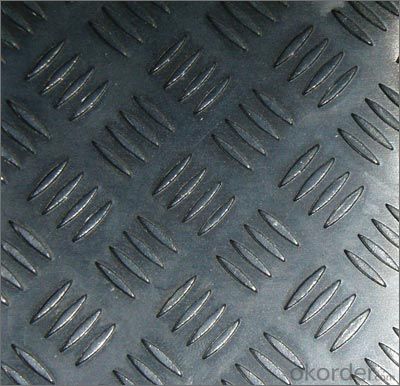
- Q:What are the different packaging options available for steel sheets?
- There are various packaging options available for steel sheets, depending on their size, shape, and intended use. Some common packaging options include: 1. Wooden crates: Steel sheets are often packed in wooden crates, which provide sturdy protection and prevent damage during transportation. The sheets are secured inside the crate using straps or bands to ensure they remain in place. 2. Steel frames: Another option is to package steel sheets in steel frames. This method provides extra protection and stability, especially for larger or heavier steel sheets. The frame is designed to securely hold the sheets in place and prevent any shifting during transit. 3. Coil packaging: Steel sheets that are in the form of coils are often packaged differently. They can be wrapped in plastic or paper to protect them from moisture, dust, and other environmental factors. The coils are then typically placed on pallets to facilitate easy handling and transportation. 4. Bundles: Steel sheets can also be bundled together using steel straps or bands. This packaging method is commonly used for smaller sheets or when multiple sheets need to be packaged together. The bundles can be further secured with shrink wrap or plastic covers to ensure they stay intact during shipping. 5. Custom packaging: Depending on specific requirements or customer preferences, steel sheets can be packaged in custom-designed packaging. This can include using foam padding or inserts to protect delicate or sensitive surfaces, or using specialized containers for specific applications such as food-grade steel sheets. Overall, the packaging options for steel sheets are diverse and can be tailored to meet the needs of different industries and customers. The choice of packaging will depend on factors such as sheet size, weight, level of protection required, and transportation method.
- Q:What is the difference between a pre-annealed and full hard steel sheet?
- A pre-annealed steel sheet is a sheet that has undergone an annealing process to relieve internal stresses and enhance its formability. It is softer and more malleable compared to a full hard steel sheet. On the other hand, a full hard steel sheet has not undergone any additional treatment after being cold-rolled, making it harder and less ductile. It is typically used for applications requiring higher strength and stiffness.
- Q:What is the average weight of a steel sheet?
- The weight of a steel sheet can differ based on its dimensions, thickness, and type of steel utilized. Nevertheless, as a general rule, a typical steel sheet measuring 1m by 1m and with a thickness of 1mm usually weighs approximately 7.85 kilograms. It is crucial to recognize that this estimation is only an approximation, and the actual weight may fluctuate depending on the precise attributes of the steel sheet. For a precise weight, it is advisable to seek advice from the manufacturer or consult the specifications of the steel sheet.
- Q:Can steel sheets be used for electrical transformers?
- Yes, steel sheets can be used for electrical transformers, particularly in the core construction. The high magnetic permeability of steel allows for efficient transfer of electrical energy and reduces energy losses. Steel sheets are often laminated to minimize eddy currents and improve transformer performance.
- Q:How do steel sheets perform in terms of thermal expansion?
- Steel sheets have a relatively low coefficient of thermal expansion, meaning they expand and contract less than many other materials when exposed to temperature changes. This property makes steel sheets ideal for applications where dimensional stability is crucial, as they are less likely to warp or distort due to thermal fluctuations.
- Q:Can steel sheets be used in mining applications?
- Yes, steel sheets can be used in mining applications. Steel sheets are commonly used in mining due to their durability, strength, and resistance to wear and tear. They can be utilized in various mining equipment such as conveyor systems, ore processing machinery, and storage containers to handle the harsh and demanding conditions commonly found in mining operations.
- Q:How do steel sheets perform in high-humidity environments?
- Steel sheets perform well in high-humidity environments due to their corrosion-resistant properties. The steel's protective coating prevents moisture from penetrating the surface, minimizing the risk of rust and deterioration. However, it is essential to ensure proper maintenance and ventilation to prevent condensation buildup and potential damage over time.
- Q:What are the safety precautions for handling steel sheets?
- Some safety precautions for handling steel sheets include wearing appropriate personal protective equipment (PPE) such as gloves, safety glasses, and steel-toed boots to protect against cuts and impact injuries. It is essential to use proper lifting techniques and equipment to avoid strains or back injuries. Additionally, steel sheets should be stored and stacked securely to prevent them from falling and causing accidents. Regular inspections for sharp edges, rust, or other potential hazards should be conducted, and any damaged or defective sheets should be replaced. Proper training and communication among workers is crucial to ensure everyone is aware of the safety procedures and practices to follow while handling steel sheets.
- Q:What are the different sheet metal forming techniques for steel sheets?
- Steel sheets can be shaped into desired forms and structures using various techniques for sheet metal forming. Below are some common techniques used for steel sheets: 1. Bending: To create angles, curves, or complex shapes, the sheet is bent either manually or with the help of machines like press brakes. 2. Stretch forming: This technique involves stretching and forming the sheet over a mold or die, especially for large and curved components. 3. Deep drawing: By using a punch and a die, the sheet metal is formed into desired shapes, often used for cylindrical or box-like structures such as cans, pots, or automotive components. 4. Roll forming: The sheet metal is passed through a series of rollers to gradually shape it into the desired form. This technique is commonly used for producing long and continuous shapes like rails, tubes, or channels. 5. Spinning: A spinning tool is used to rotate the sheet metal against a mandrel, shaping it into cylindrical or conical shapes such as lampshades or cookware. 6. Embossing: This technique involves stamping a pattern or design onto the sheet metal to create a raised or recessed surface. It is commonly used for decorative purposes or to enhance the structural integrity of the sheet. 7. Hydroforming: Hydraulic pressure is utilized to shape the sheet metal into complex forms, often employed in the creation of automotive components like car body panels or exhaust systems. These examples illustrate the wide range of sheet metal forming techniques available for steel sheets. The choice of technique depends on the desired shape, complexity, and specific requirements of the application.
- Q:What are the different quality standards for steel sheets?
- There are several different quality standards for steel sheets, including ASTM (American Society for Testing and Materials), AISI (American Iron and Steel Institute), JIS (Japanese Industrial Standards), and EN (European Norms). These standards outline specific requirements for various aspects of steel sheets, such as chemical composition, mechanical properties, dimensional tolerances, and surface finish. Compliance with these standards ensures that steel sheets meet certain quality and performance criteria and can be used for specific applications in various industries.
1. Manufacturer Overview |
|
|---|---|
| Location | |
| Year Established | |
| Annual Output Value | |
| Main Markets | |
| Company Certifications | |
2. Manufacturer Certificates |
|
|---|---|
| a) Certification Name | |
| Range | |
| Reference | |
| Validity Period | |
3. Manufacturer Capability |
|
|---|---|
| a)Trade Capacity | |
| Nearest Port | |
| Export Percentage | |
| No.of Employees in Trade Department | |
| Language Spoken: | |
| b)Factory Information | |
| Factory Size: | |
| No. of Production Lines | |
| Contract Manufacturing | |
| Product Price Range | |
Send your message to us
Hot Rolled Steel Chequered Skid Resistance Sheets Chequer Plates
- Loading Port:
- China main port
- Payment Terms:
- TT or LC
- Min Order Qty:
- 25 m.t.
- Supply Capability:
- 10000 m.t./month
OKorder Service Pledge
OKorder Financial Service
Similar products
New products
Hot products
Related keywords
